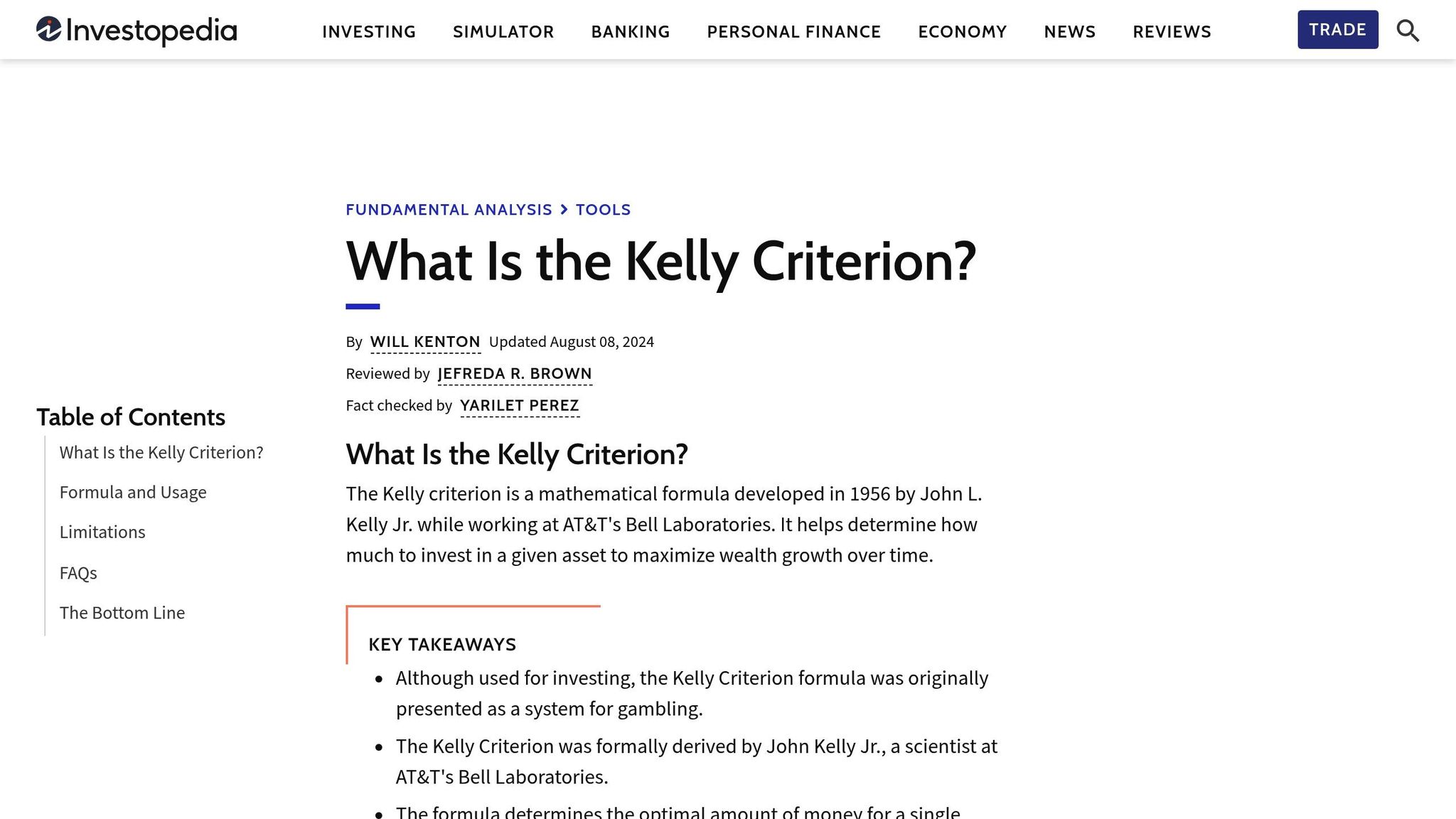Want to win at sports betting? Start by protecting your bankroll. Over 95% of bettors lose money, but you can avoid that by managing risks wisely. The key isn’t just picking winners – it’s about disciplined money management. Here’s how:
- Set a Betting Budget: Use only disposable income and keep it separate from daily expenses.
- Limit Your Bets: Bet just 1-2% of your bankroll per wager and cap daily/weekly losses.
- Choose Bet Sizes Smartly: Use fixed or percentage-based bets to manage risk.
- Diversify Your Bets: Spread wagers across sports and bet types to lower overall risk.
- Track Results: Record every bet to analyze and improve your strategy.
La gestione del bankroll nelle scommesse sportive | Il libro completo ...
Setting Up Your Betting Budget
Having a clear betting budget is crucial. Without defined limits, even seasoned bettors can unintentionally exhaust their funds. Let’s dive into what a betting budget involves and how to set one up.
What is a Betting Budget?
A betting budget, often called a bankroll, is the specific amount of money you set aside solely for sports betting. Keeping this money separate from your everyday finances helps safeguard your essential expenses. Think of it like an entertainment fund – similar to what you’d allocate for dining out or going to the movies.
"Managing your bankroll means you’re less likely to fall into these traps. The goal is to treat your bankroll like an entertainment budget. Keep it low and try not to exceed it to avoid unnecessary financial difficulty." – thesportsgeek.com
Calculating Your Budget Size
To figure out your betting budget, consider your financial situation and your approach to risk. Here’s a simple guideline to help you decide:
| Livello di rischio | Monthly Income Allocation | Example (Based on a $5,000 Monthly Income) |
|---|---|---|
| Conservatore | 2–3% | $100–150 |
| Moderato | 4–5% | $200–250 |
| Aggressivo | 6–8% | $300–400 |
Stick to disposable income only. If you’re new to betting, start small, adjust based on risk tolerance, and allow time for your bets to play out.
Creating Betting Limits
Setting strict limits is key to protecting your bankroll. Many experienced bettors use the following rules:
- Limit individual bets to 1–2% of your total bankroll.
- Set a daily loss cap around 15%.
- Establish a weekly loss cap near 30%.
For example, with a $1,000 bankroll, you’d bet $10–20 per wager, cap daily losses at $150, and limit weekly losses to $300. These boundaries help shield your bankroll during inevitable losing streaks, ensuring you can continue betting responsibly over the long term.
Smart Bet Sizing Methods
Bet sizing plays a key role in achieving long-term success in sports betting. Below are some practical approaches to help you determine the right bet size for your strategy.
Scommesse fisse o percentuali
Fixed betting means placing the same wager amount each time, making it simple and predictable. On the other hand, percentage-based betting adjusts your stake based on the size of your bankroll, providing flexibility as your funds change. Each method has its own strengths and is suited to different types of bettors.
| Betting Method | Vantaggi | Il migliore per |
|---|---|---|
| Scommesse fisse | • Easy to manage and track • Consistent stake size |
Beginners and those preferring stability |
| Percentage-Based | • Adjusts to bankroll changes • Limits losses during downturns |
Bettors who prefer dynamic adjustments |
For fixed betting, pick a stake size that can endure a losing streak without draining your bankroll. Percentage-based betting naturally adjusts to your bankroll, helping to manage risk as it grows or shrinks.
Using the Criterio di Kelly

The Kelly Criterion is a formula designed to calculate the ideal bet size based on your perceived edge. As Scommessa e abilità explains:
"Kelly´s theory is designed to maximize the growth of your bank roll (e.g. a betting fund) over the long term by determining the optimal stake on a bet."
Many experienced bettors use a fractional version of the Kelly Criterion – like Half-Kelly – to reduce risk. For instance, if you estimate the NY Knicks have a 55% chance of winning at -110 odds (implied probability of 52.5%), the Kelly Criterion might suggest wagering around 5% of your bankroll. Using Half-Kelly would cut that amount in half, offering a more cautious approach.
Adjusting Bets by Confidence
Your confidence in a particular prediction can also guide your bet size. Evaluate your confidence carefully and avoid risking more than 5% of your bankroll on any single wager.
sbb-itb-6ef1185
Spreading Your Betting Risk
Once you’ve established a disciplined approach to budgeting and bet sizing, the next step is to spread out your bets. By diversifying your betting portfolio, you can better protect your bankroll from significant losses. Let’s break down how placing wagers on different sports, using various bet types, and avoiding related bets can help reduce overall risk.
Betting on Different Sports
Placing bets across multiple sports can shield you from the impact of unexpected events in a single sport. As Diversified Fund explains:
"Actively maintaining diversification prevents events that affect one sector from affecting an entire portfolio, making large losses less likely".
For example, if an unpredictable outcome affects your bets on football, having wagers on basketball or tennis can help balance out the loss.
Mixing Bet Types
Using a variety of bet types is another way to manage risk. Some common options include:
- Moneyline bets: Scegliere il vincitore assoluto di una partita.
- Point spread bets: Betting on the margin of victory, which levels the playing field.
- Totals (over/under) bets: Wagering on the combined score of both teams.
- Prop bets: Focusing on specific game events, like a player’s performance.
For instance, in an NBA game, dividing your wager among a moneyline bet, a point spread bet, and a prop bet can help reduce the impact of an unexpected result.
Steering Clear of Related Bets
Avoid placing multiple bets that are tied to the same outcome, as this increases your risk. For example, combining a moneyline bet with a first-half spread, or a team total with the game total, can leave you vulnerable if things don’t go as planned. Instead, focus on bets that are independent of one another, like wagering on different games or leagues.
This approach mirrors expert advice to limit diversification to around 20 independent positions. By doing so, you can protect your bankroll from concentrated losses while maintaining opportunities for steady returns.
Measuring Your Results
Tracking your betting performance is crucial for refining your strategy over time. Here’s how you can effectively monitor and analyze your bets.
Keeping Accurate Records
Detailed records are the backbone of improving your betting approach. Make sure to log the following for every wager:
- Data e ora of the bet
- Sport ed eventi details
- Bet type and odds
- Stake amount
- Risultato and resulting profit or loss
- Note on your decision-making process
By recording both wins and losses, you can uncover patterns that work and steer clear of approaches that don’t.
Key Performance Numbers
To measure your success, focus on these key metrics:
| Metrico | What It Tells You | Typical Range |
|---|---|---|
| Return on Investment (ROI) | How much profit you’re making compared to your total investment | 3–6% |
| Yield | How efficiently you’re using your betting capital | Depends on your strategy |
ROI gives you a snapshot of your overall profitability, while Yield highlights how effectively you’re putting your money to work. Together, they provide a solid foundation for evaluating your performance.
Bet Tracking Tools
Bet tracking tools can simplify performance analysis, streamline data management, and help you refine your strategy. Here’s what they can do:
- Performance Analysis: Pinpoint which sports, markets, and timings are most profitable.
- Data Management: Import historical data, test staking plans, evaluate parlay bets, and monitor multiple sportsbooks in one place.
- Strategy Optimization: Experiment with new systems, identify losing trends early, and fine-tune stake sizes to maximize returns.
These tools not only save time but also provide the insights you need to make better-informed decisions.
Conclusione
Managing risk effectively is the foundation of long-term success in sports betting. As Doc’s Sports emphasizes, your bankroll is your most important resource, and disciplined management is what separates consistent winners from those who lose it all. Take the example of Chris H. from Homewood, CA – he grew his $700 bankroll to $2,800 through careful management but saw it drop to $1,400 after falling into the trap of overbetting.
"In essence, good ‘money management’ is a lot like playing good defense. Money management will allow you to ‘stay in the game’ during tough times so that good handicapping strategies (your offense) can put you ahead".
To apply these risk management principles effectively, consider these key steps:
- Keep a separate bankroll exclusively for betting.
- Limit each wager to just 1-2% of your total bankroll.
- Start with flat betting before trying advanced strategies.
- Track every single bet to monitor and improve your performance.
The strategies discussed – budgeting, sizing bets carefully, diversifying, and tracking results – work together to create a solid framework for consistent betting success. These methods not only safeguard your bankroll during losing streaks but also position you to capitalize during winning runs.
Sports betting success takes patience, discipline, and careful risk management. Treating it as a steady, long-term endeavor rather than a quick money-making scheme will help you grow profits sustainably over time.



